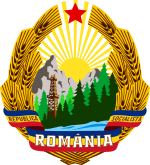Systematization (Romania)
| Part of a series on the |
| Socialist Republic of Romania |
|---|
 |
Systematization (Romanian: Sistematizarea) was a program of urban planning in the Socialist Republic of Romania from 1974 to 1989.
Systematization was carried out by the Romanian Communist Party under the leadership of Nicolae Ceaușescu, impressed by the ideological mobilization of North Korea under its Juche ideology, with the stated goal of turning Romania into a "multilaterally developed socialist society". It consisted largely of the demolition and reconstruction of existing settlements, in whole or in part, in order to urbanize and modernize the country. Systematization was controversial for the mass demolition of historic centers which became known as Ceaușima.
Reconstruction of rural areas
[edit]


Romania had traditionally been a largely rural country, with the vast majority of the population living in villages when the Romanian Communist Party (PCR) came to power after World War II. By the early 60s, the rural population still amounted for two-thirds of the population.[1]
Systematization began as a programme of rural resettlement: the original plan was to bring the advantages of the modern age to the Romanian countryside. For some years, rural Romanians had been migrating to the cities (including Ceaușescu himself) which led to some urbanization. Systematization called for doubling the number of cities in Romania by 1990, with hundreds of villages to become urban industrial centres via investment in schools, medical clinics, housing, and industry. As part of this plan, smaller villages (typically those with populations under 1,000) were deemed "irrational" and listed for reduction of services, forced removal of the population, and physical destruction. Often, such measures were extended to the towns that were destined to become urbanized, by demolishing some of the older buildings and replacing them with modern multi-storey apartment blocks.[citation needed] Some of these towns include Bezidu Nou, Ganaș, Eteni and the village of Cucu in Odoreu.
In theory, the systematization plan extended to the entire country, though initial work centred on the northeastern region of Moldavia. It also affected such places as Ceaușescu's own native village of Scornicești in Olt County, where the Ceaușescu family home was the only older building left standing. The initial phase of systematization had largely petered out by 1980, at which point only about 10% of new housing was being built in rural areas. Given the lack of budget, in many regions systematization did not constitute an effective plan, good or bad, for development. Instead, it sometimes constituted a barrier against organic regional growth. For example, new buildings had to be at least two storeys high, meaning that low-income peasants could not afford to build houses themselves. Yards were restricted to 250 square metres (2,700 square feet) and private agricultural plots were banned from within the villages. Despite a perceived impact of such a scheme on subsistence agriculture, after 1981 villages were required to be agriculturally self-sufficient.
In the 1980s, nearby villages surrounding Bucharest were demolished, often in service of large scale projects such as the Danube–Bucharest Canal – projects which were later abandoned by Romania's post-communist government.
Cities
[edit]


In cities, the systematization programme consisted of demolishing existing buildings (often historic) and constructing new ones in their place. Iași, for instance, underwent major transformations in the 1970s and 1980s.[2] Although tower blocks and other socialist-era buildings are present in all big cities across Romania, the degree to which the historic buildings (old town areas of cities) were affected varies by city. For instance old historical architecture managed to largely escape demolition in some cities, particularly in cities such as Cluj, where the reconstruction schemes affected primarily the marginal, shoddily built districts surrounding the historical city centre.
Bucharest Civic Centre
[edit]

The mass demolitions that occurred in the 1980s, under which an overall area of 5.9 square kilometres (2.3 sq mi) of the historic centre of Bucharest was levelled in order to make way for the grandiose Centrul Civic and House of the Republic, becoming the most extreme manifestation of the systematization policy. Many monuments were demolished including 3 monasteries, 20 churches, 3 synagogues, 3 hospitals, 2 theatres, and the Stadionul Republicii, a noted Art Deco sports stadium. This also involved evicting 40,000 people with only a single day's notice and relocating them to new homes.
Reactions
[edit]
Systematization, especially the destruction of historic churches and monasteries, was protested against by several nations, especially Hungary and West Germany, each concerned for their national minorities in Transylvania. Despite these protests, Ceaușescu remained in the relatively good graces of the United States and other Western powers almost to the last, largely because his relatively independent political line rendered him a useful counter to the Soviet Union in Cold War politics.
In Romania, the demolition campaign was nicknamed Ceaușima, a portmanteu of Ceaușescu and Hiroshima, in reference to the destruction caused by the atomic bombing of the city.
See also
[edit]- Urban planning in communist countries
- Ceaușima
- Juche
- Hunger circus
- HLM (France)
- Street dogs in Bucharest
Eastern bloc housing:
- Panelák (Czechoslovakia)
- Panelház (Hungary)
- Plattenbau (East Germany)
- Ugsarmal bair (Mongolia)
- Khrushchyovka (Soviet Union)
Bibliography
[edit]- Anania, Lidia; Luminea, Cecilia; Melinte, Livia; Prosan, Ana-Nina; Stoica, Lucia; and Ionescu-Ghinea, Neculai, Bisericile osândite de Ceaușescu. București 1977–1989 (1995). Editura Anastasia, Bucharest, ISBN 973-97145-4-4. In Romanian. Title means "Churches doomed by Ceaușescu". This is very much focused on churches, but along the way provides many details about systematization, especially the demolition to make way for Centrul Civic.
- Bucica, Cristina. Legitimating Power in Capital Cities: Bucharest – Continuity Through Radical Change? (PDF), 2000.
References
[edit]- ^ "Rural population (% of total population) - Romania | Data".
- ^ "Iasi - Prezentare Generala". www.monumenteiasi.ro.
